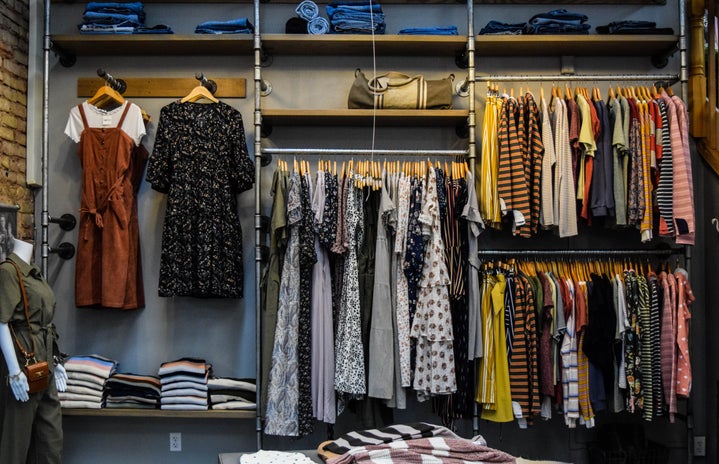“Fast fashion” is a term used to describe the rapid production of inexpensive clothing by mass-market retailers in response to the latest trends. These mass-market retailers don’t follow the standard fashion calendar either. While fashion companies used to release two collections a year, brands now release 52 micro-collections a year, sometimes releasing new items multiple times a week.
Trends change so quickly — mass-market retailers keep turning out new items to stay-on trend, and consumers keep buying them to try and keep up. Their ability to stay up to date has allowed these companies to stay profitable while they continue to cut corners and make the garments cheaply without quality-control (which explains the many missing buttons and broken zippers).
Examples of fast fashion companies include: H&M, Zara, Forever 21, Shein, ASOS, Boohoo, Zaful, Fashion Nova, Topshop, Misguided, UNIQLO, GAP and even Target.
With all of these companies hustling to produce new items, the fashion industry has become the second largest polluter in the world. Below are some eye-opening ‘fun’ facts about fast fashion:
-
The fashion industry produces 10 percent of all humanity’s carbon emissions — that’s more emissions than all international flights and maritime shipping combined.
Source: World Economic Forum
-
The fashion industry is the second-largest consumer of the world’s water supply.
Source: World Economic Forum
-
The world consumes about 80 billion new pieces of clothing each year, which is above 400 percent more than we did two decades ago.
Source: The True Cost
-
On average, people bought 60 percent more garments in 2014 than they did in 2000, but they only kept the clothes for half as long.
Source: World Economic Forum
-
On average, we only wear garments 7 times before getting rid of them.
Source: Sustain Your Style
-
Three years is the average lifetime of a garment.
Source: Sustain Your Style
-
Most women only wear 20-30 percent of the clothes they own.
Source: Sustain Your Style
-
About 85 percent of all textiles go to the dump each year which is enough to fill the Sydney Harbor between one and two times annually.
Source: World Economic Forum
-
The equivalent of one garbage truck full of clothes is burned or dumped in a landfill every second.
Source: World Economic Forum
-
Only 15 percent of clothing is recycled or donated —the rest goes directly to the landfill or is incinerated.
Source: Sustain Your Style
-
The fashion industry is responsible for 20 percent of all industrial water pollution worldwide. This is because textile textile dyeing is the world’s second-largest polluter of water, partly because the leftover water is often dumped into ditches, streams, or rivers.
Source: World Economic Forum
-
The dyeing process uses enough water to fill 2 million Olympic-sized swimming pools each year.
Source: World Economic Forum
-
About 2.6 percent of the global fresh water is used to produce cotton when 750 million people don’t have access to drinking water.
Sources: Sustain Your Style; Sustain Your Style
-
It takes about 700 gallons of water to produce one cotton shirt. That’s enough water for one person to drink at least eight cups per day for three-and-a-half years.
Source: World Economic Forum
-
It takes about 2,000 gallons of water to produce a pair of jeans. That’s more than enough for one person to drink eight cups per day for 10 years.
Source: World Economic Forum
-
Synthetic fibers are in 72 percent of our clothing and take up to 200 years to decompose.
Source: Sustain Your Style
-
Washing clothes releases 500,000 tons of microfibers into the ocean each year — the equivalent of 50 billion plastic bottles.
Source: World Economic Forum
If you’re interested in figuring out what your personal impact is on the environment, use ThredUp’s Fashion Footprint Calculator (and be sure to read the tidbits of information that accompany each question).
Now, that being said, having clothing from fast fashion brands does not make you a bad person. I have my fair share of clothing from fast fashion brands, but I personally choose not to purchase from them anymore. Not everyone can afford to purchase from sustainable brands — they are much more expensive and often are not size inclusive. But there are other steps you can take to reduce your impact. Purchase less clothing and make sure you are getting good use out of the items you do have. Do your laundry less — you can wear most clothing more than once before washing it. Make sure if you are getting rid of clothing, that you are donating, selling or repurposing it, instead of throwing it away. The list goes on and anything helps to combat fashion’s impact on the environment.


